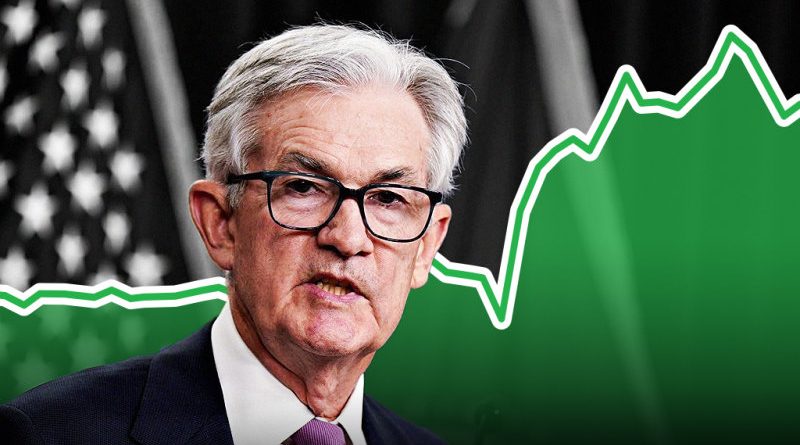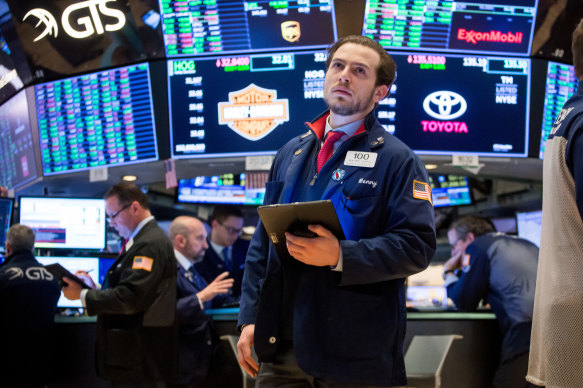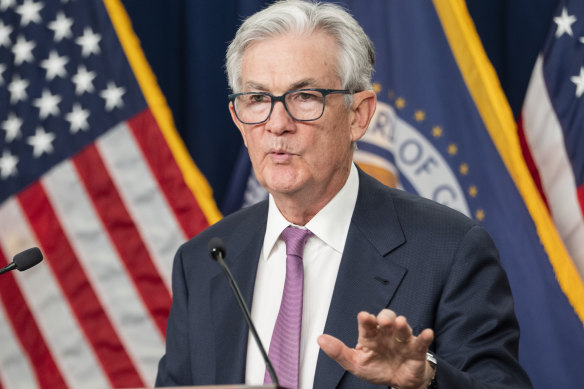How the Fed chief lit a fire under markets with a few words
The immediate response of financial markets to the US Federal Reserve Board’s decision to raise US interest rates again was a sell-off in the sharemarket. Then, however, chairman Jerome Powell gave a press conference.
The difference in tone between what the Fed said in its formal statement and what Powell said in the press conference resulted in a turnaround in the sharemarket of more than two percentage points, with the market bouncing back to close more than one per cent higher and technology stocks two per cent. Bond yields eased, with the yield on the benchmark 10-year bonds falling 11 basis points.
Wall Street swung into the black on Powell’s speech, with the benchmark S&P 500 index surging to its highest mark since August.Credit:Bloomberg
In its statement, the Fed’s Open Market Committee that sets the federal funds rate announced a 25 basis points increase and said it expected “ongoing increases” in the rate would be appropriate to achieve a monetary policy stance that would be sufficiently restrictive to return inflation to two per cent over time.
The rate rise was the eighth in the cycle that started with a similar increase in March last year, with four 75-basis-point increases and a 50-basis-point rise in the intervening period.
While market participants noted that the language in the statement had shifted from references to the pace of future rate rises to their extent, suggesting the Fed can see an end to the cycle, it was generally regarded as “hawkish,” hence the markets’ initial reactions.
Powell, however, while declaring it premature to declare victory over an inflation rate that has fallen from 9.1 per cent in June last year to 6.5 per cent in December, also said it was “certainly possible that the Fed could keep its benchmark rate below five per cent and that the Fed could bring inflation back down to two per cent without a significant economic downturn. The current Fed target range for the federal funds rate is 4.5 to 4.75 per cent.
At the moment, he said, the Fed was “talking about a couple more rate hikes to get to that level we think is appropriately restrictive.”
While he also said he didn’t see the central bank cutting rates this year (which is the scenario implied by bond market pricing and the sharemarket) he did say that if inflation were to come down much more quickly it would play into the policy settings.
“We can now say, I think, for the first that the disinflation process has started,” he said, although it was in its early stage and “the job is not fully done.”
“We’re going to be cautious about declaring victory and sending signals that we think the game is won,” Powell said.
“Certainty is just not appropriate here.”
While there were some mixed messages in Powell’s comments – there may or may not be “a couple” of rate rises to come and the Fed may or may not be cutting rates towards the end of the year – there was a definite softening of the stance, consistent with the markets’ view that the peak, or terminal, policy rate is not very far away.
The Fed has entered the delicate and grey area for central bankers where pushing rates too high, or leaving the rates too high for too long, could be unnecessarily destructive of economic activity.
Alternatively, if the federal funds rate were to plateau too early, or the Fed started reducing the rate prematurely, it might trigger a new outbreak of inflation and be forced into more draconian responses to bring it under control.
Jerome Powell’s speech had some mixed messages, but investors seized on his optimistic regarding the fight against inflation.Credit:AP
The Fed’s strategy appears to be to slow the size and, perhaps, the pace of rate rises to give it time to evaluate incoming economic data. It will err on the side of conservatism while still trying to engineer the soft landing that Powell believes is still achievable.
“My own assessment is that positive (economic) growth will continue but at a subdued pace,” he said.
The markets concur. The US sharemarket has been on a tear so far this year, with the S&P 500 up more than seven per cent in the belief that, not only will rates peak and then begin to subside later this year, but that the economy will avoid a Fed-induced recession.
How the differences in expectations between the Fed and the markets plays out is of great importance, and not just to the US, its economy and its financial markets.
Indeed, perhaps the best indicator of the renewed confidence and appetite of investors for risk is the 43 per cent rise in the Bitcoin price this year, to just under $US23,750, and the 36 per cent increase in the value of the overall crypto market, to just over $US1 trillion ($1.4 trillion). A “risk-on” environment is well and truly back.
That means financial conditions have eased even as monetary policy continues to tighten. Apart from the rate rises, the Fed is still pursuing quantitative tightening, allowing $US95 billion a month of the securities it bought in response to the pandemic to mature each month without reinvesting the proceeds.
Powell was unperturbed about the divergence between market expectations and the Fed’s view that its policy stance wasn’t yet sufficiently restrictive, saying the bank’s focus wasn’t on short-term moves.
He said he wasn’t concerned that the bond market was pricing in one more rate rise before a pause and that, if the Fed did see inflation coming down much more quickly than it currently expects it would “of course” play into its policy settings.
How the differences in expectations between the Fed and the markets plays out is of great importance, and not just to the US, its economy and its financial markets.
US monetary policy, and its markets, influence policies and markets globally. Other central banks can’t risk getting too far out of kilter with the Fed because of the threat of destabilising flows of capital and their implications for currencies.
In the near term, there is an increasing risk that if the markets’ expectations of peak US rates this year and a soft landing for the economy are upended by any data that contradicts that view (or there is no resolution of the US debt-ceiling stand-off) equity, bond and currency markets could react quite violently.
In the longer term, if the Fed misjudges its control of inflation and ends the cycle too early, US rates will rise sharply from their already-elevated base and the US economy will plunge into recession, with ripple effects throughout the globe.
The Business Briefing newsletter delivers major stories, exclusive coverage and expert opinion. Sign up to get it every weekday morning.
Most Viewed in Business
From our partners
Source: Read Full Article




